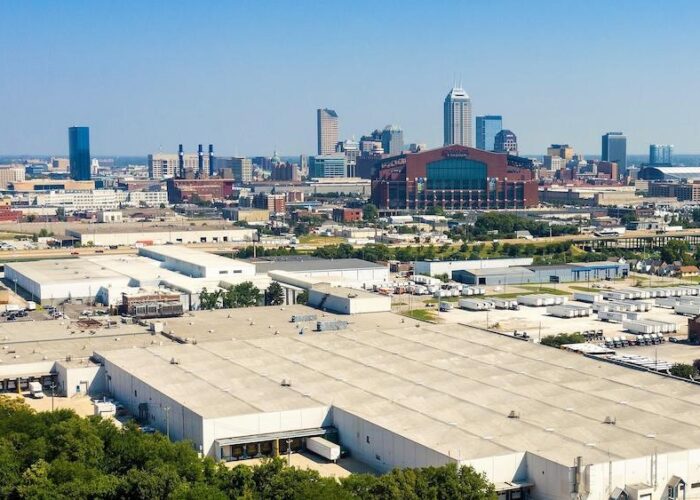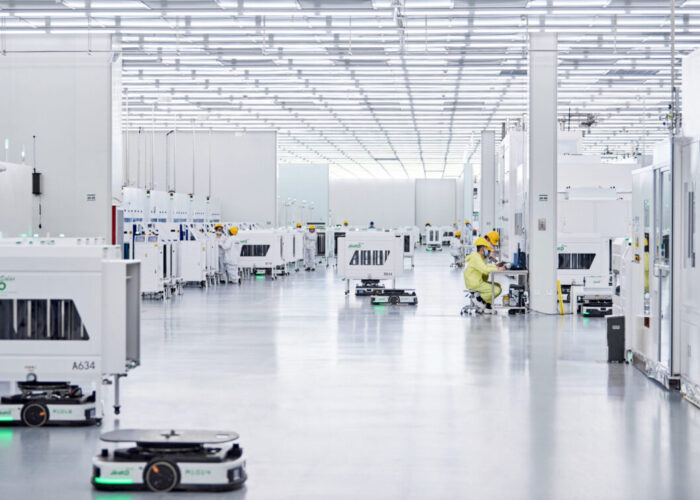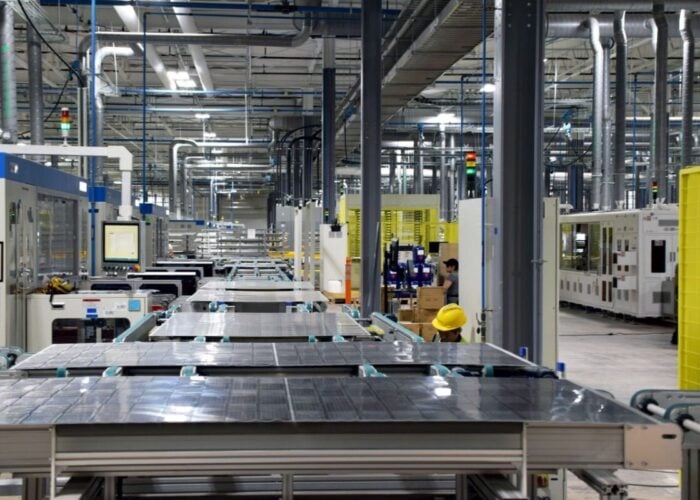
PV CellTech 2017 takes place in Penang, Malaysia, on 14-15 March 2017, and we were delighted when we caught up with Qi Wang at JinkoSolar, who is delivering one of the keynote presentations on the morning of 15 March, titled: Record efficiency of industrial screen-printed multi c-Si solar cells.
JinkoSolar’s participation at PV CellTech is essential. The company has propelled itself into the clear top position for c-Si module supply to the industry, and has plans for c-Si module shipments in 2017 that could easily exceed 10GW if the company over-performs on its recent shipment guidance for this year.
Unlock unlimited access for 12 whole months of distinctive global analysis
Photovoltaics International is now included.
- Regular insight and analysis of the industry’s biggest developments
- In-depth interviews with the industry’s leading figures
- Unlimited digital access to the PV Tech Power journal catalogue
- Unlimited digital access to the Photovoltaics International journal catalogue
- Access to more than 1,000 technical papers
- Discounts on Solar Media’s portfolio of events, in-person and virtual
Indeed, JinkoSolar’s ambition is incredible to see, and the company is clearly driving demand, in a way that we have not seen so far in the industry. It is moving the industry into an altogether new phase of growth.
With JinkoSolar also seeking to have leading market-share across almost all global end-markets, knowing the cell technologies being adopted and as part of capacity expansions is paramount to every manufacturer, not to mention downstream installers and EPCs.
Historically, JinkoSolar was mainly focused on the cost-reduction side of GW-level cell manufacturing, and was heavily reliant on cells from other cell producers for use in its modules. This all changed a couple of years ago, and JinkoSolar now has R&D activities and capex allocations that make the company a technology-innovator, and not just following mainstream trends.
The location of PV CellTech in Malaysia is also topical, as JinkoSolar has selected Malaysia as its overseas hub for Southeast Asia cell and module production.
Let’s review our Q&A with Qi Wang, and then make some observations:
What topics are going to be included in your presentation?
Qi Wang: Update the JinkoSolar R&D effect to lead the manufacturing of PV modules.
What are the biggest challenges today for PV cell manufacturers?
Not clear what [the] next PV technologies for solar cell mass production [will be]; [the] lack of low cost and good (reliable, stable, repeatable, etc.) equipment for solar cell mass production; [the] endless reduction of cell manufacturing cost.
What are the main things you are hoping to learn after the two days of PV CellTech 2017?
Get [an] update [on] cell technology and manufacturing status; especially, about PERC cell manufacturing – why there [is] so [much] capacity build up and only a few [cells] produced in 2016?
PV Tech: JinkoSolar’s strategy, both for manufacturing and global sales and marketing, is fascinating to observe today, and the company is putting markers in the sand that are both offensive and defensive in nature, somewhat in equal measures. It is a very powerful position to carve out, and this extends to wafer and cell technologies being pursued.
This is clear to see from the recent announcements to add multi-GW levels of mono wafer capacity, mirrored by mono-PERC additions. However, multi is still seeing heavy commitment, and this is reflected in the title of the talk from JinkoSolar at PV CellTech.
Given the current crossroads the p-type industry is at, regarding mono and multi, having the ability to run multi-GW activity across both p-mono and p-multi is almost ideal, and allows JinkoSolar to benefit in equal measures from the competitive activities from the mono and multi specialist wafer/cell producers this year.
Perhaps the most interesting comment from our interview with Qi Wang is related to the comment on the lack of PERC production, in contrast to the regular announcements we have been hearing in the industry on PERC, or the myriad of demo modules shown at the industry’s main exhibitions during 2016.
It is a question I get regularly when talking to people, and I think there are many factors at play here. I’m sure many will be addressed and discussed at PV CellTech, and here we may get the most useful inputs from the equipment suppliers of PECVD and laser patterning tools.
First, the move to PERC is happening rapidly, and the capacity plans and full line integration plans are being done at a frantic rate. It always takes time to get things optimized quickly when implementing new process flows, and of course, it needs the entire cell production line to be optimized, not simply rear side deposition and laser openings. Everything needs to work together on the cell lines. PERC is not an instant drop-in solution: it takes time.
We also have the mono/multi aspect, and it is no surprise that processing on mono wafers, at the cell stage, is simply easier, and process windows are wider, while secondary loss mechanisms are easier to understand and control. Only 2-3 cell makers have succeeded in moving directly to p-multi PERC: the others are likely to follow, but only once p-mono PERC is fully controlled from a standard-deviation and manufacturing cost standpoint.
The final issue that surely impacts on PERC production levels relates to the equipment supply-chain, and it is interesting to see Qi Wang flag the equipment side of things. PV equipment supply is such an integral part of PV CellTech this year, complemented by materials supply, and we have added a panel session discussion on equipment.
Specifically for PERC, Meyer Burger has been the dominant company for PECVD supply, following market-share successes seen before by the company it acquired several years ago, Roth & Rau. While Roth & Rau was focused on SiN deposition on the front side, revenues from Meyer Burger have a strong contribution from rear-side materials deposition in the PERC process.
Laser equipment supply has also often been from European based laser tool integrators (InnoLas and 3D-Micromac), with many of the leading PERC producers today opting for supply from one of these two companies.
However, for both PECVD and laser ablation, PERC is also seeing strong participation from Chinese tool suppliers.
Historically, cell manufacturing tools were the exclusive domain of European, US, and Japanese equipment suppliers. This started to change during the first Chinese expansion phase in the industry during 2009-2012, with domestic Chinese equipment suppliers seeing order uptick for furnaces (diffusion and firing), PECVD and wet-etching benches.
However, when companies were seeking to push the limits of cell efficiency, or implementing advanced cell concepts, the domestic Chinese equipment suppliers were rarely seen as options.
In fact, we could almost ring-fence screen-printing here. Up until a few years ago, all screen-printers were from a select group of companies: Applied Materials (AMAT), ASYS, DEK-Solar (now ASM Alternative Energy), Jonas & Redmann (or JRT), and Seishin. Of this grouping, AMAT’s Baccini operations were the clear leader, in terms of market share.
However, now we have a Chinese-based company seeing strong market-share gains for screen-printing, and winning business previously seen as safe territory for AMAT. This company is called Maxwell Technologies, and this now means that Chinese equipment suppliers are now active across all parts of cell production lines.
Returning to the PERC production issue now, and many of the Chinese-centric lower tier cell producers have chosen to adopt a strong China-only equipment supply tactic. Given what we know about the challenges in getting the process windows tied down with PERC (mono or multi), it is perhaps not surprising that some observers are questioning the suggested mismatch with PERC capacity announcements and modules hitting the end-market.
When Qi Wang comes on stage at PV CellTech 2017 on the morning of 15 March, the entire audience will be gripped by what is being proposed by JinkoSolar and the company’s thoughts on the cell manufacturing landscape today. When industries have clear market-share leaders that are pulling away, their every word and sentiment is eagerly followed. We expect nothing less in Penang next week!
PV CellTech takes place on 14-15 March 2017 in Penang, Malaysia. To register to attend the event, please register using this link.







